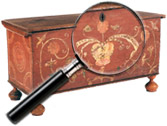|
|
Lenticular
Lenticular means, “1. shaped like a biconvex lens; 2. of or relating to a lens; 3. convex on both sides; lentil-shaped.”
In the world of collectibles, “lenticular” usually refers to a type of printing that creates a three-dimensional image through the use of a lenticular lens. The resulting images reveal changes in depth or motion as the viewing angle changes. (“Lenticular” doesn’t refer, despite the frequent use, necessarily to the image, but to [...] Click here to continue reading.
Newell Convers Wyeth (1882 to 1945)
N.C. Wyeth was born Newell Convers Wyeth on October 22, 1882 in Needham, Massachusetts, the oldest of four boys, who spent their young lives outdoors doing farm chores, hunting, fishing, or exploring the countryside. N.C. displayed an early talent for art, encouraged by his mother, and by twelve, he was producing quality watercolors. After drafting courses at the Mechanics Arts School, he went on to study illustration art [...] Click here to continue reading.
Coca-Cola
Dr. John Stith Pemberton (1831 to 1888), an Atlanta pharmacist, invented Coca-Cola in 1886. A year earlier, he had introduced an alcoholic beverage called “Pemberton’s French wine coca”, but the temperance movement was then gathering momentum in the United States, prompting him to develop an alcohol-free product. Pemberton mixed a combination of lime, cinnamon, coca leaves, and kola nuts to make the famous beverage. When Coca-Cola was first introduced, the syrup was mixed [...] Click here to continue reading.
Joan Miro (Spanish, 1893-1983) Joan Miro lithograph, Signes Et Meteores, printed in colors, 1958, p4A item E8972489
Joan Miro was born in Barcelona, Spain, on April 20, 1893, the son of a watchmaker. From 1912 he studied at the Barcelona Ecole des Beaux-Arts and the Academie Gali. In the first quarter of the 20th century, Barcelona was a cosmopolitan, intellectual city with a craving for the new in art, music, and literature. But, it [...] Click here to continue reading.
Lithography
The word lithography comes from Greek lithos, meaning “stone” and grapho, meaning “writing.” Although “stone writing” is sometimes done today with a metal plate, traditionally the process gets its name from the use of limestone.
Lithography is made possible by one of the simplest scientific phenomena – the repelling relationship between water and oil. A hydrophobic (water-repelling) substance with a fat or oil base is used by the artist to draw the image [...] Click here to continue reading.
Robert Atkinson Fox (1860-1935)
Born Robert Atkinson Fox on December 11, 1860 in Toronto, Canada, Fox studied in Canada and Europe prior to arriving in America. He eventually went on to become one of the early 20th century’s most popular, most diverse, and most reproduced artists of his time with his work appearing as art prints, calendars, advertising pieces, ink blotters, candy and handkerchief boxes, jewelry boxes, magazine covers, children’s books, newspaper inserts, postcards, [...] Click here to continue reading.
photograph of Grandma Moses, photograph by Rudolph Rissland (p4A item E8981620) Anna Mary Robertson Moses ‘Grandma Moses’ (1860-1961)
Anna Mary Robertson, more commonly known as Grandma Moses, was born in 1860 in Greenwich, New York. She grew up in a large family, where the girls were taught how to perform a variety of domestic tasks. After she married Thomas Salmon Moses, Grandma Moses spent nearly 20 years raising her children on their farm. [...] Click here to continue reading.
John James Audubon (1785 to 1851)
John James Audubon was born in Haiti on April 26, 1785 on a sugar plantation, the son of Lt. Jean Audubon, a French naval officer, and Audubon’s mistress, Jeanne Rabin, a Louisiana chambermaid. After the death of Jeanne Rabin and a slave uprising that convinced Audubon’s father to give up his holdings in the colony, John James Audubon, still a toddler, and his younger sister returned to France [...] Click here to continue reading.
The Battleship Maine
Construction of the U.S.S. Maine was authorized in August of 1886, and she was launched in 1889 and commissioned in 1895. After several years spent patrolling the East Coast and Caribbean, orders sent the Maine and her crew to Cuba in response to continued civil unrest on the island.
The photograph above is a 1896 image of the ship framed in a sheet iron frame made from remnants of [...] Click here to continue reading.
Hoosier and the Hoosier Group
The word “Hoosier” is one of those words whose origins are lost to time. Even The Oxford English Dictionary offers no real guidance about where the word came from. What we do know is that “Hoosier” was first documented in the mid-1820s, and within a decade, it had entered general usage. John Finley, a Hoosier himself from Richmond, write a poem titled, “The Hoosier’s Nest” that was published in [...] Click here to continue reading.
|
Recent Articles
- Charles Alfred Meurer – American Artist & Tromp L’Oeil Artist
- Sendak, Maurice – American Artist & Writer
- Godie, Lee – American Artist
- Davis, Vestie – American Artist
- Bartlett, Morton – American Artist
- Mackintosh, Dwight – American Artist
- Evans, Minnie Jones – African-American Artist
- Mumma, Ed (Mr. Eddy) – American Artist
- Nice, Don – American Artist
- Savitsky, John (Jack) – American Artist
- Gordon, Harold Theodore (Ted) – American Artist
- Dial, Thornton – African-American Artist
- Doyle Sam – American Artist
- Johnson, Lester Frederick – American Artist
- Finster, Howard – American Artist
|
|
